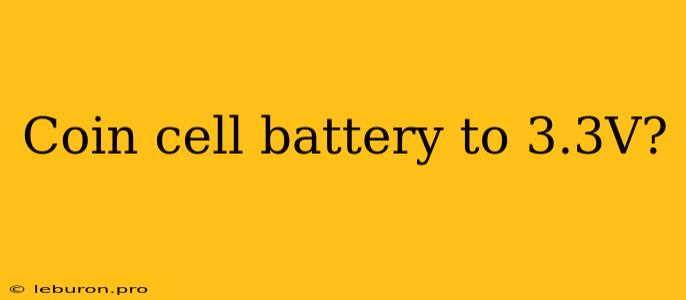Coin cell batteries, those tiny powerhouses found in everything from watches to key fobs, are known for their convenience and long lifespan. But what if you need a higher voltage than the standard 3V output of most coin cells? Enter the world of coin cell battery to 3.3V conversion. This simple yet crucial conversion process allows you to utilize these compact batteries in applications requiring a specific voltage, like powering microcontrollers, sensors, and other electronic gadgets.
Understanding the Need for 3.3V
Many modern electronic components, particularly microcontrollers and integrated circuits (ICs), operate optimally at 3.3V. This voltage ensures reliable performance and minimizes power consumption. While some coin cells come with a 3V output, they can fluctuate depending on their charge level, potentially causing instability in your circuit. A dedicated coin cell battery to 3.3V conversion is necessary to provide a consistent and reliable power supply for your devices.
The Benefits of Coin Cell Battery to 3.3V Conversion
- Stable Voltage Supply: By converting the coin cell battery to 3.3V, you eliminate voltage fluctuations that can disrupt the operation of your electronics.
- Improved Efficiency: A stable 3.3V supply allows your circuits to operate at their optimal voltage, leading to increased efficiency and reduced power consumption.
- Extended Battery Life: A consistent 3.3V output minimizes the strain on your coin cell battery, prolonging its lifespan and reducing the need for frequent battery replacements.
- Simplified Circuit Design: Using a pre-converted voltage eliminates the need for additional circuitry, such as voltage regulators, simplifying your overall design.
Methods for Converting Coin Cell Battery to 3.3V
There are several methods to achieve a coin cell battery to 3.3V conversion, each with its own advantages and drawbacks.
1. Voltage Regulators
Voltage regulators are dedicated ICs designed to maintain a constant output voltage regardless of input voltage fluctuations.
- Linear Regulators: These regulators dissipate excess voltage as heat. They are simple to implement but can be inefficient for higher current applications.
- Switching Regulators: These regulators utilize switching techniques for greater efficiency, converting excess energy back to the input source. They are more complex but offer better power utilization.
2. Voltage Dividers
Voltage dividers utilize resistors to create a specific voltage drop from the input voltage.
- Simple and Cost-Effective: Voltage dividers are inexpensive and straightforward to implement.
- Limited Output Current: Voltage dividers have a limited output current capability, making them unsuitable for devices with high power requirements.
- Voltage Drop: The voltage drop across the divider resistors results in a loss of power, which may not be ideal for applications where efficiency is critical.
3. Dedicated 3.3V Converter Modules
Pre-designed modules are readily available, providing a convenient and efficient solution for converting coin cell battery to 3.3V. These modules typically incorporate a switching regulator or a voltage divider for precise and stable voltage output.
- Easy Implementation: These modules are plug-and-play, requiring minimal wiring and setup.
- Compact Size: Designed for space-constrained applications, these modules seamlessly integrate into your project.
- Pre-Tested and Reliable: Pre-designed modules come with inherent reliability and are thoroughly tested for optimal performance.
Choosing the Right Method
The best method for converting coin cell battery to 3.3V depends on your specific requirements.
- Power Requirements: If your device demands high current, consider using a switching regulator.
- Circuit Complexity: For simple applications, a voltage divider may suffice.
- Efficiency: Switching regulators provide the most efficient conversion while linear regulators result in greater power loss.
- Cost: Dedicated modules offer convenience but may come at a higher cost.
Safety Considerations
- Heat Dissipation: Pay attention to heat dissipation, especially when using linear voltage regulators, as they generate significant heat.
- Short Circuits: Always ensure proper wiring and avoid short circuits to protect your components and batteries.
- Polarity: Double-check the polarity of your coin cell battery and ensure correct connections to avoid damage to your electronics.
Conclusion
Converting coin cell battery to 3.3V provides a reliable and efficient solution for powering various electronic devices. Whether you choose voltage regulators, voltage dividers, or dedicated modules, carefully assess your project requirements and select the most appropriate conversion method. By understanding the principles and precautions involved, you can ensure the seamless integration of coin cell batteries into your electronic creations, enabling you to harness their compact power for a wide range of applications.
